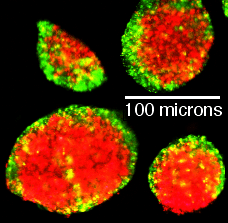Morphogenesis facts for kids
Morphogenesis is a big word that means "the beginning of shape." It's a super important biological process that explains how living things, like you, a tree, or a dog, get their unique shapes. Think about how a tiny seed grows into a big plant, or how a single cell in a mother's womb becomes a baby with arms, legs, and a face. That's morphogenesis at work!
It's one of the main ways living things grow and change. It works closely with how cells grow bigger and how they become different types, like skin cells, bone cells, or nerve cells.
Contents
What is Morphogenesis?
Morphogenesis is all about how cells arrange themselves in the right places to build a body. It makes sure that your heart forms in the right spot, your fingers grow on your hands, and your eyes are on your face. Without it, living things would just be a blob of cells!
This process controls how cells move, stick together, and divide in an organized way. It's like a master builder guiding every brick and beam to create a perfect house.
How Does Shape Form?
The way a living thing gets its shape is very complex. Cells don't just randomly grow; they follow a very specific plan. This plan tells them where to go, what to become, and how to connect with other cells. It's like a secret code inside every living thing.
Cells can also change their shape or even move around to help form different parts of the body. They might stretch, squeeze, or even fold to create complex structures.
Why is it Important?
Morphogenesis is vital for life. It ensures that every living thing develops correctly. If this process goes wrong, it can lead to problems in how a body is formed. For example, if a plant doesn't get its proper shape, it might not be able to grow strong or make seeds. If an animal's organs don't form correctly, it might not be able to survive.
It's also important for repairing parts of the body. When you get a cut, morphogenesis helps new skin cells grow and arrange themselves to heal the wound.
What Influences Morphogenesis?
Many things can influence how morphogenesis happens. It's not just about the genes inside cells; it's also about signals from outside.
Chemical Signals
One big influence comes from chemical signals. These are like tiny messages sent between cells.
- Hormones: These are special chemicals made by the body that act like messengers. They can tell cells when to grow, when to stop, or when to change their shape. For example, hormones help guide the growth of bones and muscles.
- Signals from other organisms: Sometimes, chemicals from other living things can also affect morphogenesis. This is more common in simpler organisms, but it shows how interconnected life can be.
Physical Forces
Cells also respond to physical forces, like pressure or tension.
- Mechanical stress: Imagine pushing or pulling on something. Cells in a growing body feel similar forces. These physical pressures can tell cells how to arrange themselves. For example, the way cells are squeezed or stretched can guide how tissues and organs form.
Where Does Morphogenesis Happen?
Morphogenesis happens in many places and at different times in a living thing's life.
- In an embryo: This is the most famous place. When a baby animal or plant is just starting to grow, morphogenesis is working hard to build all the body parts.
- In a mature organism: Even after a living thing is fully grown, morphogenesis can still happen. It's involved in healing wounds, replacing old cells, and even in how some animals regrow lost body parts.
- In cell culture: Scientists can grow cells in a lab, and even there, cells can show signs of morphogenesis, trying to organize themselves into tissues.
- In unusual growths: Sometimes, in certain types of unusual growths, cells can also show disorganized morphogenesis, which means they are growing in a way that doesn't follow the body's normal plan.
See also
 In Spanish: Morfogénesis para niños
In Spanish: Morfogénesis para niños


